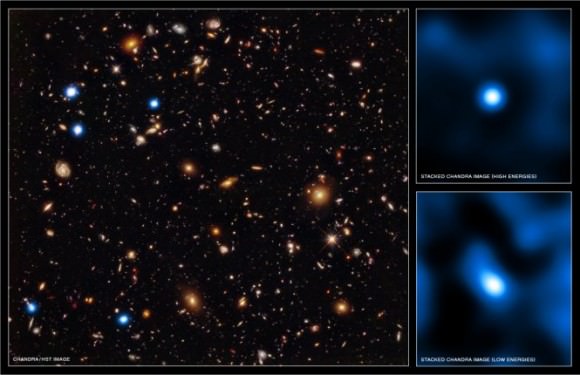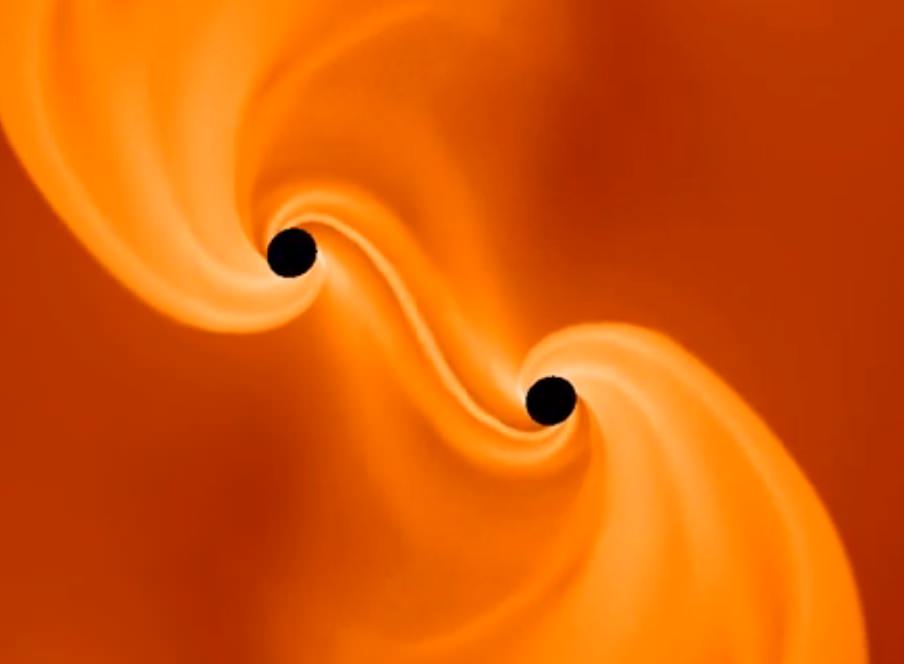It’s one of the puzzles of cosmology and stellar evolution: how did supermassive black holes get so… well, supermassive… in the early Universe, when seemingly not enough time had yet passed for them to accumulate their mass through steady accretion processes alone? It takes a while to eat up a billion solar masses’ worth of matter, even with a healthy appetite and lots within gravitational reach. But yet there they are: monster black holes are common within some of the most distant galaxies, flaunting their precocious growth even as the Universe was just celebrating its one billionth birthday.
Now, recent findings by researchers at Caltech suggest that these ancient SMBs were formed by the death of certain types of primordial giant stars, exotic stellar dinosaurs that grew large and died young. During their violent collapse not just one but two black holes are formed, each gathering its own mass before eventually combining together into a single supermassive monster.
Watch a simulation and find out more about how this happens below:
From a Caltech news article by Jessica Stoller-Conrad:
To investigate the origins of young supermassive black holes, Christian Reisswig, NASA Einstein Postdoctoral Fellow in Astrophysics at Caltech and Christian Ott, assistant professor of theoretical astrophysics, turned to a model involving supermassive stars. These giant, rather exotic stars are hypothesized to have existed for just a brief time in the early Universe.
Read more: How Do Black Holes Get Super Massive?
Unlike ordinary stars, supermassive stars are stabilized against gravity mostly by their own photon radiation. In a very massive star, photon radiation—the outward flux of photons that is generated due to the star’s very high interior temperatures—pushes gas from the star outward in opposition to the gravitational force that pulls the gas back in.
During its life, a supermassive star slowly cools due to energy loss through the emission of photon radiation. As the star cools, it becomes more compact, and its central density slowly increases. This process lasts for a couple of million years until the star has reached sufficient compactness for gravitational instability to set in and for the star to start collapsing gravitationally.
Previous studies predicted that when supermassive stars collapse, they maintain a spherical shape that possibly becomes flattened due to rapid rotation. This shape is called an axisymmetric configuration. Incorporating the fact that very rapidly spinning stars are prone to tiny perturbations, Reisswig and his colleagues predicted that these perturbations could cause the stars to deviate into non-axisymmetric shapes during the collapse. Such initially tiny perturbations would grow rapidly, ultimately causing the gas inside the collapsing star to clump and to form high-density fragments.
“The growth of black holes to supermassive scales in the young universe seems only possible if the ‘seed’ mass of the collapsing object was already sufficiently large.”
– Christian Reisswig, NASA Einstein Postdoctoral Fellow at Caltech

These fragments would orbit the center of the star and become increasingly dense as they picked up matter during the collapse; they would also increase in temperature. And then, Reisswig says, “an interesting effect kicks in.” At sufficiently high temperatures, there would be enough energy available to match up electrons and their antiparticles, or positrons, into what are known as electron-positron pairs. The creation of electron-positron pairs would cause a loss of pressure, further accelerating the collapse; as a result, the two orbiting fragments would ultimately become so dense that a black hole could form at each clump. The pair of black holes might then spiral around one another before merging to become one large black hole.
“This is a new finding,” Reisswig says. “Nobody has ever predicted that a single collapsing star could produce a pair of black holes that then merge.”
These findings were published in Physical Review Letters the week of October 11. Source: Caltech news article by Jessica Stoller-Conrad.


I’m not grasping how an object with infinite density can merge with another object of infinite density. How can a particlel of one SMB ‘jump’ to the other SMB? I picture the two SMBs rolling around next to each other for eternity, never actually merging into a single SMB.
Another imaginative “after the fact” fix to keep the standard model. It is impossible for such massive black holes to form so early in the Universe.
Super massive stars are an extension of another “after the fact fix” of the hypothetical Population III stars, which were assumed to exist in order to resolve the evidence of “metals” or elements that can only be created after a star has lived a lifetime. In an early Universe that is less than 10^9 years old this is impossible.
Such proposed stars can not exist and are unstable. Other stellar astrophysicists have asserted this as well, but their work is ignored. All we ever see published on this site, at least it seems to me, are the papers that preserve the present model, rather than the papers that indicate something is wrong. Are we going to see the paper that refutes the possibility of such large stars? I doubt it.
Big Bang was also like “supernova explosion”. Hence it must have produced plasma, individual elements like hydrogen, helium, complex elements, neutron stars, small black holes, etc.
Nobody has proved that the Big Bang produced only plasma. Hence it is possible that in the very early stage itself universe contained small black holes.
Interesting. This sounds a lot like the phenomenon of multiple vortex tornadoes. In tornadoes of a certain swirl ratio (proportional to the ratio of the rotational component of the winds to the radial [inward] component, tiny perturbations can lead to a breakdown of the initially axisymmetric flow around the (single) vortex, leading to smaller-scale vortices (often called suction vortices) that rotate around the main tornadic circulation. I imagine the fluid dynamics equations and their solutions that lead to this behavior are very similar to the ones that govern the behavior in the black hole simulation above.
When we talk about black holes merging, we are actually talking about what happens when their event horizons intersect. Anything that enters the event horizon of a black hole can never get out again, and this includes points on the surface of another black hole’s event horizon. It follows that if two event horizons touch, they must merge. What actually happens to the two singularities inside is anyone’s guess.
Thank you for the distinction. It’s easy to see how the “holes” themselves would merge regardless of the interaction of the singularities.
In addition to what Grimbold says, we actually do not know that the center of a black whole is a point of infinite density (singularity); we really have no idea what happens inside the event horizon of a black hole. While General Relativity suggests a singularity will form, this is just the type of situation in which we expect GR to break down as quantum effects should begin to dominate at that scale. It is possible that a quantum theory of gravity will contain some as-yet-unknown source of pressure that limits the collapse. I believe, for instance, that loop quantum gravity suggests a maximum density of about one planck mass per cubic planck length.
Interesting perspective. Thank you.
You should probably credit Jessica Stoller-Conrad, the freelance journalist from whose article on the Caltech website this article cribs most of its text word-for-word without attribution.
The source is clearly stated right at the end, and has been since the moment of posting.
You didn’t use her article as a source of information…you stole nearly the entirety of her article and passed it off as your own. Of the 603 words in this article, you wrote only 98; yet it appears under your byline, and I dare say UT isn’t paying her for her work. You didn’t even try to rephrase it in your own words! It’s plagiarism, pure and simple.
When media outlets for research institutions have news to spread, they put out releases and articles with their findings. This is how these discoveries and works get spread around. The source is noted and linked to, nothing is being “passed off” and the quotes are attributed. Thank you for taking the time to count the words in the article but you are waving your fists at nothing. We feature many news releases here at UT, all of them well-written by our contributors and/or their respective authors. Attribution and credit is always given. Always.
What would satisfy me is if you credited the author of the article in the byline instead of passing it off as entirely your own. This is not some anonymous press-release; it is a article written by a journalist who deserves credit for her words as much as any of the scientists she, quite properly, credits in the article she wrote.
Also, I have gone back through the past week or so of articles on UT and I find many which source material and a quote here and there, and some which borrow from anonymous press releases. There are a few which, in my opinion fail adequately to paraphrase their sources. But I have found no example (in my admittedly limited survey) of any other author on this site appropriating the entire text of a credited article and publishing it under her or his byline.
Your insatiable consideration is noted.
As is your unrepentant plagiarism.
UT credits their sources. They are one of the more credible and reputable site on the net.
Would you care to state precisely what you are objecting to in ?-CDM cosmological theory?
It is a rather long list.
For example, General Relativity and Special Relativity are in conflict. ( A gram of matter and a “gram ” of light are not equal over time.)
You can check out my ongoing criticisms of the “limited expansion” “Dark Model” by using the search terms — Youtube John Kulick
From a long list,
1. Special Relativity and General Relativity predicte inconcistent results with respect to the properties of light and matter. They are no longer equal.
I specifically define at least 10 other fundamental problems.
I watched your video “Fundamental Errors in Cosmology 1.” I confess that I fail to see the problem that you do. You seem not to be fully appreciating the implications of the different frames of reference of observers at the point of emission of the photon in question and at the point of detection. Observers in different frames of reference can disagree about the energy of a photon without there being a violation of conservation of mass-energy. For each frame of reference, the energy is unchanged (conserved) and there is simply no “stationary” frame of reference from which you can judge which of the observers is right.
You seem to not be fully appreciated the meaning of frame of reference used in the model, there is an “absolute” reference and a relative reference frame. All relative reference frames keep their relative measures in the model proposed, just as you describe.
Lets stick with just one frame of refference. We should not have any issue with the model if we use one frame of reference to describe nature.
Consider the following issue again. In Space we have 1 gram of matter, and one gram of radiant energy. The photons of light are sent off into space, travel to a distant galaxy where a large mirror is set up to reflect the light back to our gram of matter that has been sitting in space for a few billion years.
The returning photons have lost energy.
1 Tell me where did the energy Go? The energy is no longer in the observable Universe.
2 Doesn’t this violate conservation of Energy?
3 Doesn’t this mean that matter and Energy are no longer equivelent?
4 Don’t you see this as indicateing something is amiss?
5 Wouldn’t you consider a moder that maintains the equivelency between matter and energy over time a better model?